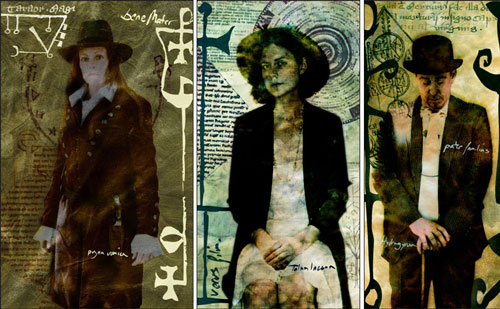Graphic Design students solve communication problems by interpreting ideas and translating them into visual systems.


GRAPHIC DESIGN



The Graphic Design major at NMU
The discipline of graphic design requires graphic designers to solve communication problems by interpreting ideas and translating them into visual systems. These ideas are intended to convey meaning to an audience. The audience may become inspired, informed, or persuaded by the message. The designer creates and directs large projects where by a design may be applied systematically. The designer’s work often involves collaboration between many individuals including the client purchasing the communication, programmers to develop interactive elements and research and development teams to provide content and data. Teamwork and communication skills are essential for the success of the designer. In the development of the solution, design objectives must allow for the constraints of time, space, budget, and technology.
The translation of ideas using visual structure such as pattern and color can be represented in two or three-dimensional form and are instrumental in crafting interactive experiences. Graphic design represents visual layout using typography, photography, and illustration that is applied to a variety of media, from printed materials to web page design and other modes of digital media.
Most design projects involve a process that starts with research and planning. As design objectives are formulated to determine the needs of communication, visual structure is used to manipulate how the audience should perceive the information. Figure ground relationships, contrast, direction, size, shape and responsiveness, are just some of the visual concepts that can create a structural information hierarchy.
The AD 118 Introduction to Graphic Design is the first course in the concentration studio core. In it students explore basic typographic principles and figure ground relationships with both electronic and hand techniques. The next course AD 218 Graphic Design: Typographic Systems involves the design of typographic layout and continued computer-based learning for print and Web. In the junior level course, AD 318 Graphic Design: Production and Layout, students design advanced publication layouts for tablet-based devices like the iPad, learn production processes and create responsive web layouts using HTML5, CSS3 and jQuery. The seniors in the AD 418 Graphic Design: Seminar course design corporate identity campaigns and use information graphics and data visualization techniques to present vast quantities of data. Lastly, the AD 455 BFA Seminar, prepares students for finding a job through self-promotion and portfolio preparation.
The graphic communication program is also home to the Presque Isle Press (PIP), a letterpress printing facility that helps expose students to the rich tradition of printing. Students are encouraged to pursue alternative methods of production using the letterpress and digital platemaker. Other classes that will support these core offerings are drawing, illustration, photography, digital cinema and electronic art & animation.
There are a variety of jobs available in this field. Everything from design firms and ad agencies to corporations to non-profit groups require graphic designers. Graduates have obtained jobs at design firms in Detroit, Chicago, Madison, Minneapolis, and San Francisco. There is an increasing need and understanding of the role of graphic communication in business.
Graphic Design Represents Visual Layout Using Type, Photo, and Illustration
Click to Learn MoreGraphic Design Studio
Technology plays an important role in Graphic Design. The school has four Mac-based labs open for use by the students. Each student leases a Mac laptop computer on a three-year cycle. Software applications used by graphic communication students are: Adobe Photoshop CC, Adobe Illustrator CC, Adobe InDesign CC, Adobe Dreamweaver CC and Adobe After Effects CC. They are all available on the MacBook laptops along with wireless Internet connection. Our lab image is state-of-the-art providing students with hardware and software to better prepare them for the working world.


The Graphics Studio is Equipped with State of the Art Computers and Multiple Printing Solutions
Click to Learn MoreGraphic Design Faculty
click to open/close
Jane Milkie
Professor
BS State Univ of New York, Buffalo
MFA Rochester Inst of Technology
Jane Milkie received her MFA in Computer Graphic Design with an additional emphasis in Graphic Design. Professor Milkie teaches Graphic Communication courses and an upper-level Art and Design Theory and Practices course. Her freelance commissioned and pro bono print and web design work serves mainly non-profit clientele. She is a member of the AIGA Professional Association for Design and the UCDA University College Design Association where she has presented at many National Design Education Summits. She also serves on a variety of Boards including Friends of the Upper Peninsula Children's Museum, The North Wind Independent Student Newspaper at NMU, The Academic Service Learning Board at NMU, and is a former board member of The Marquette Maritime Museum. She also serves as a member of the NMU AAUP, the American Association of University Professors Faculty Union, as Information Officer, rebranding their chapter logo in 2014. Prior to teaching at NMU she taught graphic design for four years at Bowling Green State University in Ohio.



Keith Ellis
Professor
BFA University of Tennessee
MFA Savannah College of Art & Design
Keith Ellis received his BFA in Art with a concentration in Graphic Design from the University of Tennessee-Knoxville, while working for web firms, print houses, and even television. After school, Professor Ellis worked in various industries including design, photography and medical education. Professor Ellis recieved his MFA in Graphic Design from the Savannah College of Art and Design
WEBSITE
kellisdesign.com

Graphics Design Courses
click to open/closeAD 218 Graphic Design: Foundations
4 credit hours
Offered: Fall, Winter
Introduction to graphic design concepts with the development of technological and craft skills. Emphasis is placed on the use of process, typography, and composition as well as foundational skills in gestalt and color theory.
AD 318A Graphic Design: Typography and Layout
4 credit hours
Offered: Fall, Winter
Prerequisite: AD 218.
Implementation of typographic systems in concept and composition. Emphasis is placed on process, letterform, and layout as well as typography’s use in interactivity and social media.
AD 318B Graphic Design: Storytelling and Production
4 credit hours
Offered: Winter
Prerequisite: AD 218.
Advanced studies in visual systems through conceptual development, production skills, and three-dimensional design. Emphasis is placed on a narrative approach to design.AD 388 Web Design
4 credit hours
Offered: Fall
Prerequisite: AD 218.
Advanced studies in the design and development of websites. Emphasis is placed on the conceptual development and layout of websites as well as their use in multiple devices and environments. Front-end HTML and CSS coding will be developed throughout the course.
AD 418 Graphic Design: Interactive Design and User Experiences
4 credit hours
Offered: Fall
Prerequisite: AD 303 or concurrent enrollment, AD 318A or AD 318B; or instructor permission.
Students will learn to apply research, problem-solving, and the user’s experience to interactivity. This course’s focus is on app/software interfaces and other media, wayfinding, and the conceptual development of interaction and design.
AD 488 Branding and Social Media
4 credit hours
Offered: Winter
Prerequisite: Senior standing and AD318A
A critical examination of branding strategies and implementation within the context of contemporary social media and design landscapes. Emphasis is placed on design research.
Graphic Design FAQ
click to open/closeWhat is Graphic Design?
Graphic Design is the study of visual form. Layouts created with typography, photography, and graphic shapes convey messages to an external source. Traditionally graphic layouts were two-dimensional and printed on surfaces such as paper. The field now includes electronic media.
Is Graphic Design Advertising?
Advertising is visual communication intended to sell a product or service. Graphic Design is more promotional by way of informing viewers and conveying information. Both fields share the intention of using visual form to convey concepts. Advertising is based off of business and marketing strategies. It might include a variety of formats such as print, TV, and outdoor advertisements. Graphic Design is the main emphasis in our program, however students are encouraged to pursue a direction they wish to explore and advertisements are included in coursework.
Note: Students enrolled in the Bachelor of Science degree program can select Art and Design Graphic Design as a major and minor in Marketing or Business Management. The minor is required to be outside of the school of Art and Design. Advertising courses are available in the College of Business.
What is the difference between Graphic Design and Electronic Art & Animation?
Graphic Design deals more with print-based media while Electronic Art & Animation deals with 3D modeling and animation. Both programs do, however, share responsibility for web design. There is some overlap between the programs and graphic design students take one of the Electronic Art & Animation courses if they are seeking a BFA degree.
What technology do graphic design students learn?
Most of the software learned in graphic design deals with print production as well as web. Adobe Photoshop CS, Adobe Illustrator CS, Quark XPress, Macromedia Dreamweaver, and Macromedia Flash are covered throughout the courses. All students lease on a three–year cycle MacBooks. Software and a wireless connection are supplied. Our labs have printers, scanners and camera equipment check-out. Printing is charged per sheet.
What is the difference between a BFA and BS or BA degree?
The BFA degree includes 40 credits in liberal studies with 87 credits in Art and Design. This degree includes the most art and design classes with a studio emphasis.
The BS and BA degrees include 40 credits in liberal studies and 63 credits in Art and Design, plus a 20 credit minor out side of the School of Art and Design. The BA requires a language minor, the BS includes all other minors not in language. These degree choices allow a studio art major to diversify their knowledge with another discipline.
What are the costs of the Program?
While all students lease a computer and it is a primary tool, there are many art supplies that will be needed for graphic design as well as other courses. Printing and mounting projects takes up the bulk of the cost. Printing is available and is charged per sheet.
What opportunities are available outside of the program?
The Art and Design Internship course is available as an elective to junior students. Students find there own positions typically during the summer. Students find internships and or freelance design work both locally and at home. Many graphic design jobs are available on the NMU campus. Work obtained before graduation expands the learning process and aids in securing a job upon graduation.
Are there jobs in the field when I graduate?
Absolutely. There are numerous occupations available to Graphic Design students from design firms to ad agencies, packaging to printing, web design and in television. Starting salaries range from $32,000 to 38,000 and go up from there based on levels of experience and portfolio work.
Should graphic designers go to graduate school?
Some students choose to enter graduate programs. Those interested in teaching graphic design enter MFA degree programs across the country.
Do I need a portfolio to become and Art and Design Graphics Design major?
No. If you are accepted at Northern Michigan University you can immediately enter the program, taking the AD 118 Introduction to Graphic Design course if it is available. The school offers the High School Freshman Scholarship (four $1000 awards) that is available each year with applications due in April.
See the web for details
Scholarship Information






















 NMU is an
NMU is an 



